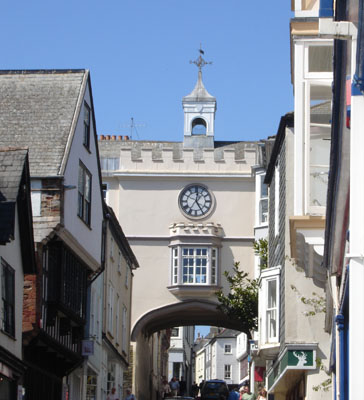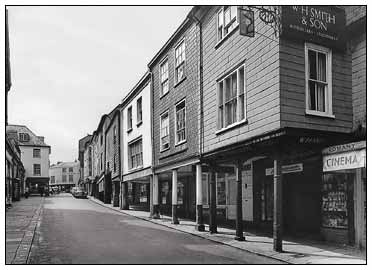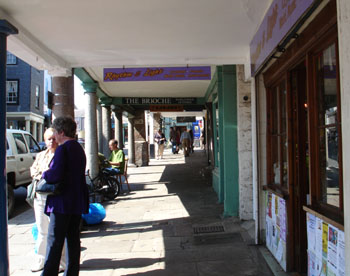Totnes, lying on the west bank of the River Dart about 8 miles from the sea, has the distinction of being the second oldest borough in England after Malmsbury in Wiltshire. The earliest record of the town dates back to the reign of Edgar (959-975), when coins were minted there for the first time. The site on which the burh was founded rises steeply from the river to a ridge upon which a motte-and-bailey castle was built in Norman times. Much of the castle remains intact, dominating the skyline from the east and the north of the town to this day.

On the north side of High Street stands the imposing Church of St Mary, with its fine red sandstone tower topped by four pinnacles. Surprisingly, the 120 foot tower is largely hidden from view in the narrow streets of the town until you are almost at the entrance.
The construction date of the church was something of a mystery before 1800, when according to William White writing in 1850 in his "History, gazetteer, and directory of Devonshire":



The reconstruction started in 1432 was not complete until 1460, when the pulpit and ornate rood screen made with stone from the Beer quarries in East Devon were added. The red sandstone for the tower, built between 1449 and 1459, was transported from nearby Stoke Gabriel. William White says of the interior shown in the 1842 print:
The second print illustrates the exterior in 1842. Major renovation work was carried out in the 1860s by Sir Gilbert Scott, a notable architect with a penchant for restoring churches in the Victorian style which was not to everyone's liking. As W G Hoskins, in "Devon", 1954, puts it pointedly:
Close to the castle, tucked away in Ramparts Walk behind the church is another Totnes building of great historic interest: the Guildhall. It was built on the site of a former Benedictine Priory dating from 1088 as a Guildhall and school, then converted into a Magistrate's Court in 1624, in which capacity it continued until as recently as 1974. It also housed the town gaol, in which prisoners were held until 1887. The building is still in use for Town Council meetings and various civic ceremonies. Some of the foundations and walls date back to the time of the Priory. The wall facing the camera is adorned with overlapping slates, a technique known as slate-hanging, a characteristic of South Devon towns that is used widely in Totnes.


An emblematic feature to be seen when making your way up the hill in the centre of the town is the East Gate arch, first rebuilt early in the 16th Century, and again in 1990 after it was largely destroyed by fire. Set back from the road before you reach East Gate is the attractive Presbytery fronted by a pretty garden.

Move up the hill through East Gate and you are in High Street; on the right is the Butterwalk, an old shopping arcade with the first storey overhangs supported by stone pillars. The black-and-white photo shows how it looked in the 1950s, viewed through a very wide-angled lens. The Butterwalk looks much the same in 2007, though the shops are different and the traffic has increased somewhat!


Moving to the top the hill we reach The Narrows, an extension of the high street graced with an eclectic amalgam of specialist shops each one privately run, epitomizing the Totnes shopping experience. Among these is Sacks Wholefoods, a provider of the best quality vegetarian food since way back. I recall buying sacks of brown rice there in the mid 1970s when my two boys were growing up in the area.


The black and white picture of the Butterwalk is reproduced by kind permission of ©The Totnes Image Bank
The prints of St Mary's Church are reproduced from the Devon Libraries Local Studies Service ©Etched on Devon's memory series.